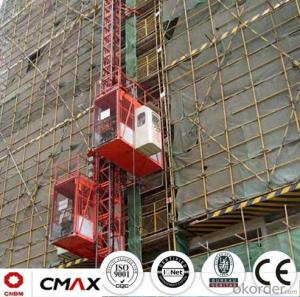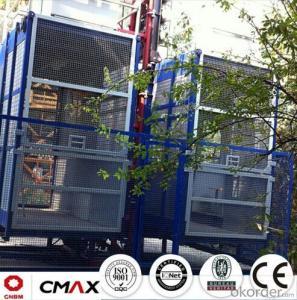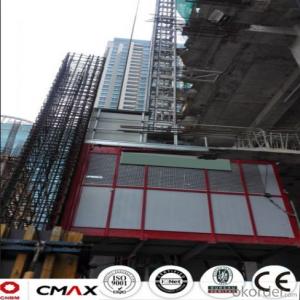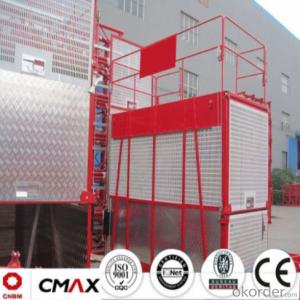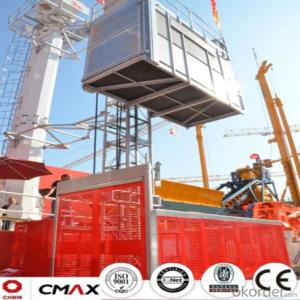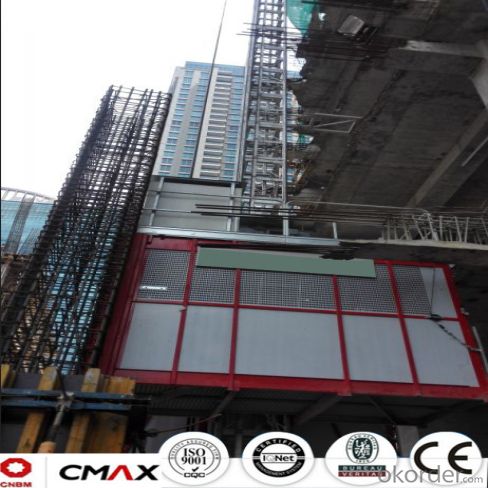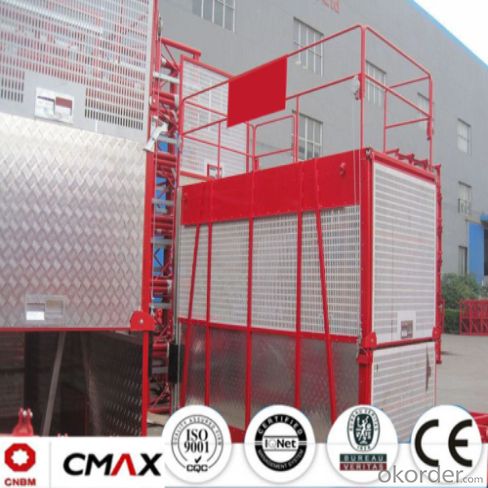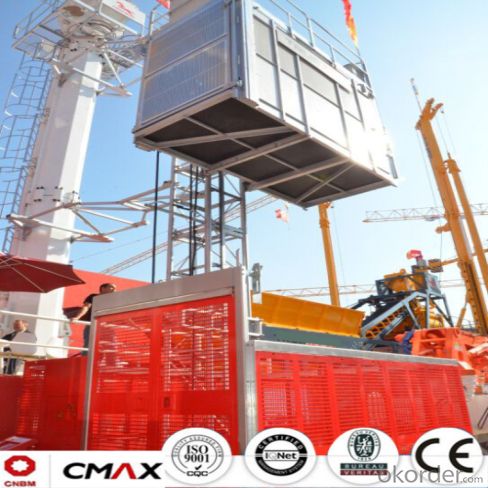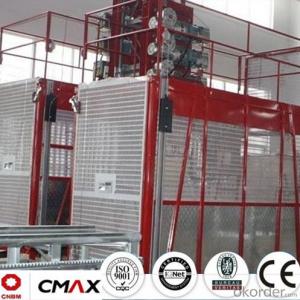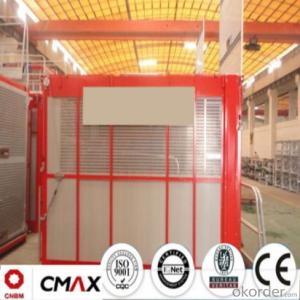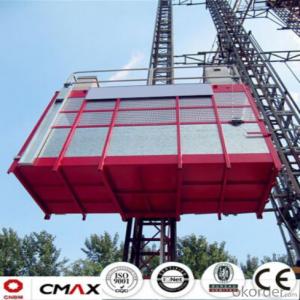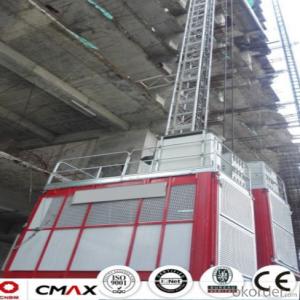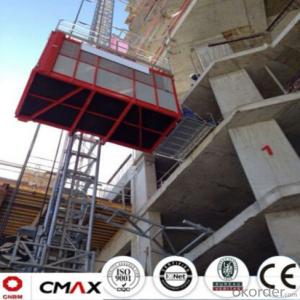Building Hoist European Standard Electric Parts with Max 5.4ton Capacity
- Loading Port:
- China main port
- Payment Terms:
- TT OR LC
- Min Order Qty:
- 1 unit
- Supply Capability:
- 10 unit/month
OKorder Service Pledge
OKorder Financial Service
You Might Also Like
Structure of Building Hoist with Max 5.4tons Capacity Description
The hoist can be widely used in industrial and civilian construction, bridge, under well, big chimney as well as shipping industry to carry people and materials. As permanent or semi-permanent equipment, hoist can be used in different sites such as warehouse, high tower, etc.
With the advantages of reliable performance, safety, easy carrying, high adaptability, it can reduce operators’ work intensity.
With many advanced technology integrity, strict control on each making process, high ratio of price and quality, CMAX hoist has become a symbol of lifter with high quality and excellent after-sales service.
Packaging & Delivery of Building Hoist with Max 5.4tons Capacity
Packaging: nude and wooded box Delivery: 25-30days
Mains Parts of Building Hoist with Max 5.4tons Capacity
1.Metal structure including the mast, tie in and cabin ,could be spay-painted and hot galvanized. Mast section is produced with high quality Q345B seamless steel pipe.
2.The electrical system can be adopted with the normal control method and VVVF+PLC control method. Inverter we adopted is from Schneider. Yaskawa and other world famous brand.
3.Electric parts are all equipped with Schneider , Siemens and other top brands.
4.Cabin exit door adopts ramping type. The ramping door likes a bridge between the building hoist and construction building.
Building Hoist with Max 5.4tons Capacity Images



Building Hoist with Max 5.4tons Capacity Specification

FAQ of Building Hosit with Max 5.4tons Capacity Capacity
Q: What is the main structure of building hoist?
A: The P/M construction hoist mainly contains metal structure, driving system, electrical control system, cable guide & protection system, electrical top crane and safety device.
Q: What is the building hoist main purpose?
A: Building hoist equipped with double or single cabin to transport the materials and labors up and down. It's the ideal construction equipment for vertical transportation in the field of construction.
- Q: What are the safety measures to be taken to avoid accidents involving lifting equipment on construction sites?
- <p>To prevent accidents related to lifting equipment in construction work, several key safety measures should be implemented. These include regular inspections and maintenance of lifting equipment to ensure it is in good working order. Operators must be trained and certified for the specific equipment they are using. Safe lifting practices should be followed, such as using proper lifting techniques, not overloading equipment, and ensuring the load is balanced. A thorough risk assessment should be conducted before each lift, and a competent person should supervise the operation. Additionally, clear communication protocols should be established, and all workers should be trained in recognizing and avoiding hazards associated with lifting equipment.</p>
- Q: The difference between the derrick and the construction elevator?
- They're the same. HAULOTTE answer for you
- Q: This question asks for an explanation of the working mechanism of a building hoist, which is a device used in construction to lift materials and workers.
- <p>A building hoist, also known as a construction hoist or personnel/material hoist, is a temporary lifting device used in construction projects to transport workers and materials vertically within a building. It typically consists of a tower, a cage, a drive mechanism, and a control system. The tower is attached to the building's structure, and the cage is where people or materials are loaded. The drive mechanism, often powered by an electric motor, raises and lowers the cage along the tower. The control system manages the movement, ensuring safety features like speed control and emergency stops are in place. The hoist operates within a guide rail system, which keeps it aligned as it moves up and down the building's height.</p>
- Q: Is it possible for a building hoist to simultaneously lift and lower various materials?
- <p>Yes, a building hoist can be used to raise and lower different materials at the same time, provided it has the necessary capacity and the materials are properly secured. This is often done by using multiple hooks or platforms, each designated for different materials. It's crucial to ensure that the combined weight does not exceed the hoist's load limit and that safety protocols are strictly followed to prevent accidents.</p>
- Q: This question asks for an identification of the various types of lifting equipment that are specifically utilized in the context of building hoists.
- <p>Different types of lifting equipment used for building hoists include: 1. Electric Chain Hoists, which are versatile and suitable for various lifting tasks. 2. Manual Chain Hoists, that require manual operation and are used for lighter loads. 3. Electric Wire Rope Hoists, known for their high lifting capacity and durability. 4. Air Hoists, which are powered by compressed air and are ideal for environments where electricity is hazardous. 5. Geared Winches, used for pulling or lifting heavy loads with precision. 6. Jib Cranes, which provide a fixed or semi-fixed lifting solution in workshops. 7. Gantry Cranes, used for lifting heavy loads over a specific area. Each type serves specific purposes and is chosen based on the weight, environment, and specific requirements of the construction project.</p>
- Q: This question asks if a building hoist is capable of lifting objects that vary in size and weight.
- <p>Yes, a building hoist can be used to lift objects of different sizes and weights, but it is crucial to ensure that the hoist's capacity is suitable for the load. Building hoists are designed to handle various materials and equipment during construction, and their lifting capacity can range from a few hundred pounds to several tons. It is essential to check the hoist's specifications and adhere to the maximum load limit to ensure safety and prevent damage to the hoist or the objects being lifted. Always follow the manufacturer's guidelines and safety standards when operating a building hoist.</p>
- Q: What are the financial expenses associated with buying and keeping a building hoist in good condition?
- <p>The costs of purchasing and maintaining a building hoist include the initial purchase price, which can range from $10,000 to $50,000 depending on the hoist's capacity and features. Maintenance costs involve regular inspections, lubrication, and part replacements, averaging around $1,000 to $3,000 per year. Operating costs include labor for hoist operation and potential rental fees if the hoist is not owned. Additionally, there may be costs for safety training and compliance with regulations. These costs can vary widely based on the specific hoist model, usage frequency, and local regulations.</p>
- Q: The maximum allowable deviation of the vertical is the vertical degree when the construction elevator is installed
- 5 kinds of circumstances. 1: the height of the elevator guide frame is less than 70 meters, and the vertical deviation should not be greater than one in 1000 of the height of the guide frame. (assuming the rail frame is 70 meters high, the deviation cannot be greater than 70mm) 2: the rail frame is greater than 70 meters and is less than 100 meters, and the deviation is less than or equal to 70 mm. 3: the guide frame is larger than 100 meters and is less than 150 meters. The deviation is less than or equal to 90 mm. 4: the guide frame is larger than 150 meters is less than or equal to 200 meters. The deviation is less than or equal to 110 mm. 5: the guide frame is greater than 200 meters, and the deviation is less than 130 mm. This is based on the requirement of 5.2.2.1 from GB10054 to 2005. (it used to be a direct copy.)
- Q: For example, what records do you want to have a third party monitoring?
- The elevator overhaul formalities; First report to the local special court, after the approval of the major repair, the major repair unit should have a major repair record to leave the record of party a, including the replacement parts or the procedure that changes. Then the local special inspection hospital will be required to check again.
- Q: Is it safe to use a lifting device with someone who has no experience with it?
- <p>It is generally not advisable to use a lifting device with someone who is not familiar with it. Lifting devices require proper training and understanding of their operation to ensure safety. Using such equipment without proper knowledge can lead to accidents and injuries. It is crucial to ensure that anyone operating a lifting device has received the necessary training and is familiar with the specific device's safety protocols and operation procedures.</p>
Send your message to us
Building Hoist European Standard Electric Parts with Max 5.4ton Capacity
- Loading Port:
- China main port
- Payment Terms:
- TT OR LC
- Min Order Qty:
- 1 unit
- Supply Capability:
- 10 unit/month
OKorder Service Pledge
OKorder Financial Service
Similar products
Hot products
Hot Searches
Related keywords
